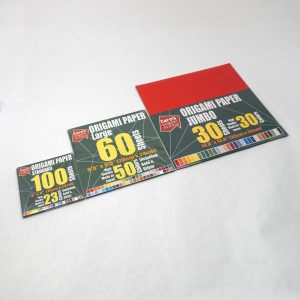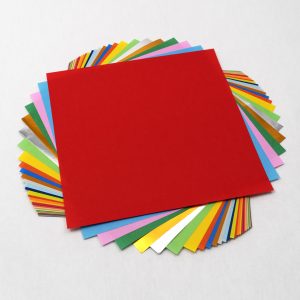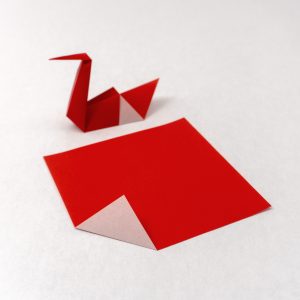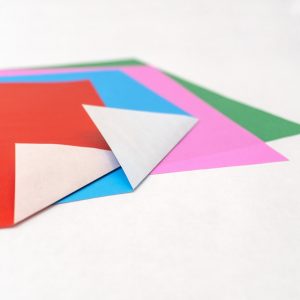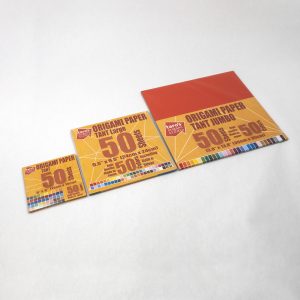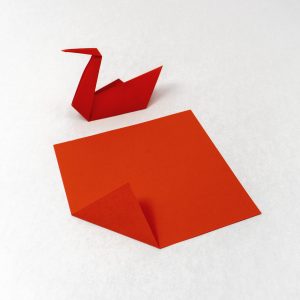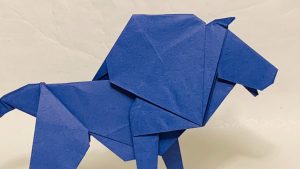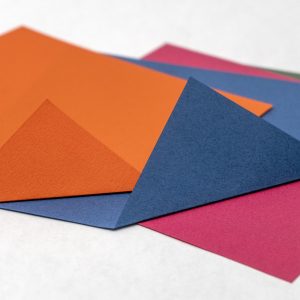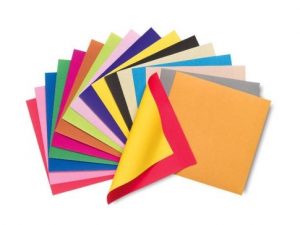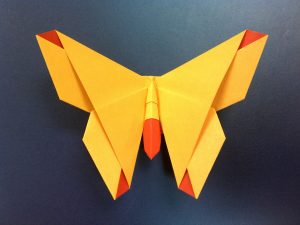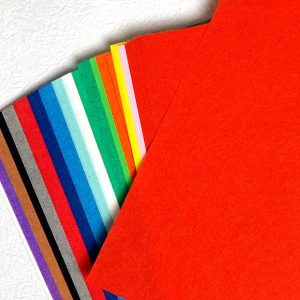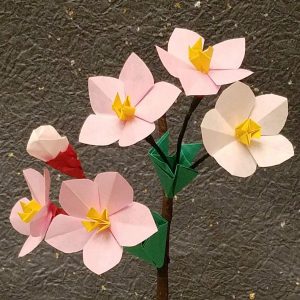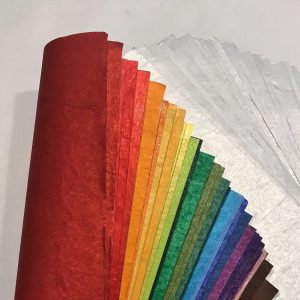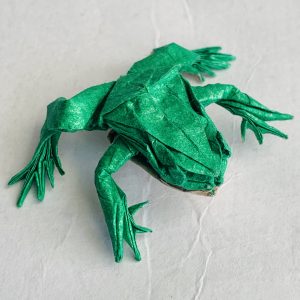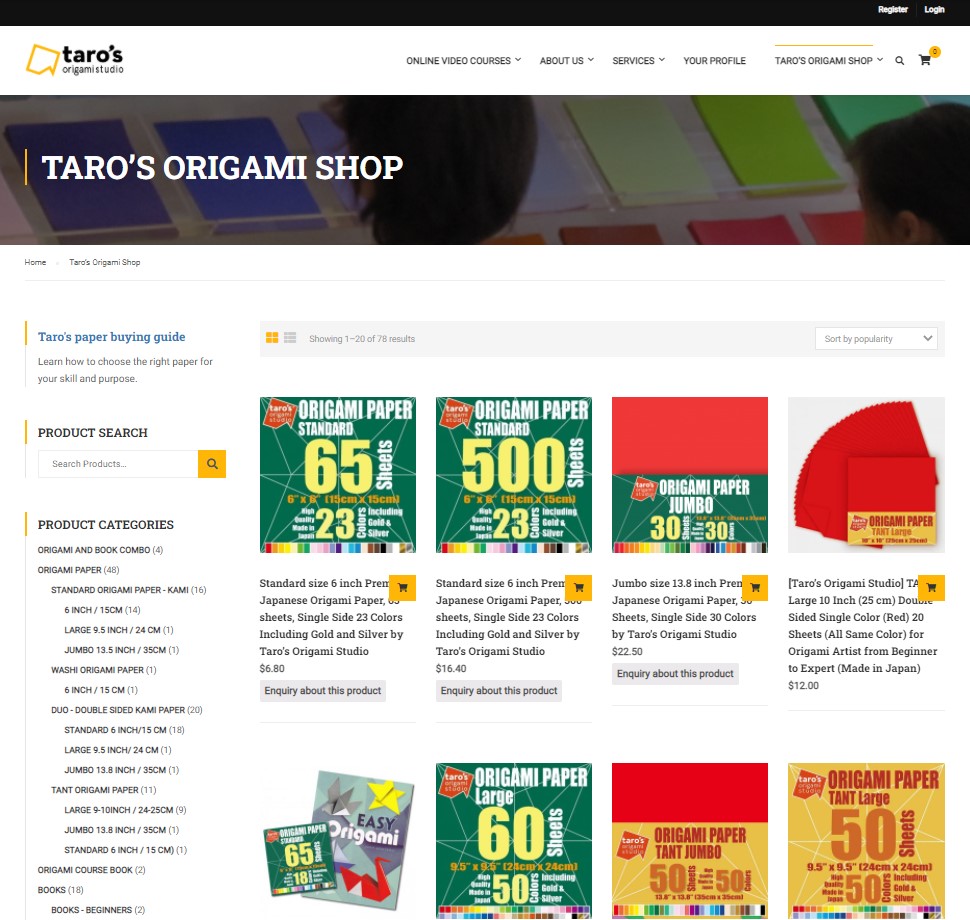折り紙の世界をご案内します。
The Paper Basics
折り紙は、折り紙用の紙を使うことで、より質の高い作品を作ることができます。つまり、コピー用紙や色画用紙は、折り紙には向かないということです。 このガイドでは、折り紙プロジェクトに使用する紙を選ぶ際の、さまざまな重要な要素について説明します。
Printing-
折り紙の印刷工程は、折り畳みやすく、割れにくい紙を作るために重要です。日本の高品質な印刷所では、無害で長持ちするインクを使い、紙の繊維の隙間にインクを充填して、非常に滑らかな折り面を作り出します。また、この工程では、紙を折ったときにインクが浸透しているので、紙を折り曲げたときに白が透けて見えたり、ひび割れたりすることがないのです。これは、インク代を節約するために中国紙でよく行われる、紙の繊維を先に染めて色紙を作るという安価な方法よりはるかに優れています。 以下、その工程をご覧ください。
Paper Thickness-
The thickness of your origami paper is crucial to determining the types of models that you can fold, but there are trade-offs. Super thin paper can be folded into many layers without being bulky, but is often fragile and can break if folded in the same place repeatedly. On the other side of the spectrum, super thick paper will be very hard to crease multiple times but will be very strong. For example, think about the advantages and drawbacks of trying to fold a model with these types of paper:
- Facial tissue
- Copy paper
- A cardboard box
Obviously none of these paper are ideal for folding origami. One one hand, the facial tissue would be thin enough for lots of layers, but isn't strong enough to withstand a lot of folding and on the other hand, the cardboard box would be very strong, but too thick to fold very much at all. Paper made for origami tries to combine these two aspects by being both thin AND strong, but each type of origami paper is better or worse suited to different models. In fact, paper thickness is so critical to origami, often the paper you choose determines the types of models that you can make. Correspondingly, if you chose a model to fold- it can often only be folded out of certain kinds of paper, so start with what you care most about, (the models or the paper) and work from there.
Here is a quick video showing the exact thicknesses of the papers we offer and an overview of their features as well:
The Paper Types
1. Standard Origami Paper or " Kami":
The Best Paper for Most Folders and Models
The best paper for origami is called "Kami" (the Japanese word for origami paper), the standard origami paper. Kami comes from Japan in factories that have been around for generations and have staff that have honed their skills over many years. They start with white base paper and ink or stamp various colors and designs onto it depending on the type of origami paper being created. So one of the feature of the Standard origami paper is that it has color on one side and the other side is white. Uncolored standard paper (or a pure white sheet) is .066 millimeters, paper dyed on one side (like every sheet other than white) is .071 millimeters thick.
The standard origami paper" kami" varies in size from around 7.5cm x 7.5cm (about 3 inch) all the way up to 35cm x 35 cm (about 14 inch) squares and can be used for most kinds of origami.
+ Holds creases very well and is very easy to use.
+ Best for practice origami: It’s one of the least expensive versions of origami paper.
+ Perfect for simple or intermediate-level models, easy modulars, casual folding and beginners.
+ Larger sizes are the best starting option for super-complex models.
+ Standard is widely available.
+ Comes in a variety of around 100 different colors and most variety of different sizes.
2. Tant Paper:
The Best Paper for Showcasing your Origami
If you wish to display your origami work to others, we recommend using Tant paper. This paper has a beautiful patterned texture and a nice sheen on the surface. Tant has a thickness of .118 millimetres per sheet, so it is thicker than all standard sheets.
The meaning of the term Tant is "a lot," which means an abundance of color. Tant paper has become famous in the Japanese origami world because it is a dyed fiber paper that does not break even after repeated creases and can keep beautiful surface texture. Tant paper is made by Hokuetsu Paper Mill Company and is only made in Japan.
Tant paper is the most used paper among origami folders, after standard.
If the standard origami is a not-so-expensive paper for practice, then the Tant paper is the exhibition paper for the main event. In other words, Tant paper is more expensive compared to standard origami but it will upgrade the look of your origami creations.
3. Duo Color Standard
A Classic Two-Color Option
This paper is another kind of standard paper, but has both sides dyed with ink. When this is done properly, this requires a second inking process, but in cheaper versions of duo paper (particularly in China) the fibers themselves are dyed to save ink and money. It can be different colors on each side of the sheet, or it can also be the same color on both sides. This paper is more expensive than single color standard because of the second inking run, but less expensive than Tant. Duo is also only available in complimentary color combinations as well as the same color on both sides. Because of the extra layer of ink it is the thickest of the standard sheets measuring .076 millimeters per sheet.
4. Washi
A Paper with Texture
Washi is a traditional Japanese paper that’s made using long plant fibers. This paper has a very unique Japanese feel, and was originated by Japanese masters that have passed the skill on for generations. It is usually very thin and is often fabric-like to the touch. Washi paper comes in 50 sheet multicolored packs. Each sheet is .094 millimeters thick so it is thicker than all of the standard sheets, but thinner than Tant.
+ Washi is very thin, strong, and durable, and can be wet-folded because it has long fibers and there is no glue in the paper to hold it together.
+ Models folded with washi paper appear a bit more life-like because of the texture- the paper is very soft.
+ Every sheet is unique because of the fibers, and larger rolls are available.
- Washi is generally available only in basic colors.
5. Tissue Foil Paper
An Option for Advanced Folders
This paper has a color tissue paper to one or both sides of a sheet of aluminum foil sheet. Tissue foil is one of the easiest papers to use for origami, because it is a combination of foil and tissue paper. The foil makes it strong and stiff while the tissue makes it more flexible and can provide a wide variety of colors or patterns. In the past the only way to get this paper was to make it yourself, which can be costly and time consuming. It’s pretty thin, and can come in some of the largest sheets for origami paper available- up to 45cm squared (17 inches)
+ This is one of the easiest kinds of origami paper to use since it’s so thin and strong.
+ It comes in larger sizes, and is perfect for super complex folding
+ Each sheet is unique and has it's own texture.
+ It holds creases very well and the foil helps models hold their shaping.
- This paper is more expensive than others.
- It is an advanced paper and takes some practice to learn how to fold and shape the paper well.


